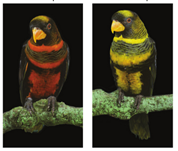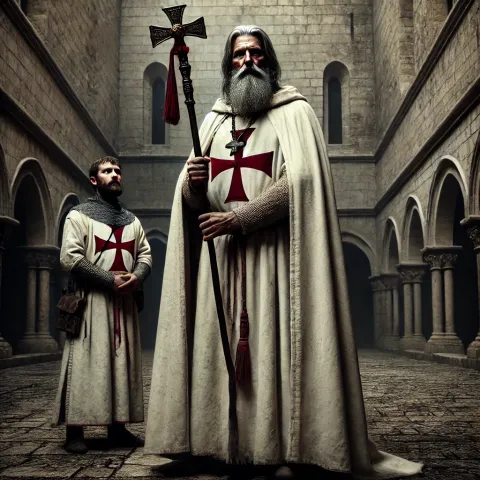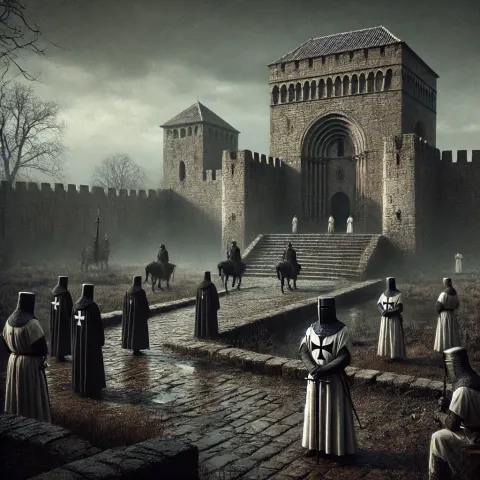He chose a new and a tough spear
lest the wood of the former might have been strained in the previous encounters he had sustained. Lastly, he laid aside his shield, which had received some little damage, and received another from his squires.

Recent news
Parrots are unique when it comes to color: with their yellow and red feathers, they are among the most colorful animals in the world. Despite their flashy appearance, scientists have long struggled to understand how parrots got their unique color palette.

Unique pigments
How do parrots get their color? To answer this question, scientists first showed that the yellow and red pigments in parrot feathers do not occur in other birds. The scientists themselves found this hard to believe at first, but the genetic tests proved true: the pigments in parrot feathers are unique.
One protein turns red feathers yellow

The scientists then did further research on White-backed Lorikeets, orange-yellow birds native to Papua New Guinea. They discovered that only one protein controls the color difference in White-backed Lorikeets.
Oddly enough, this is the same protein that is responsible for breaking down alcohol in the liver in humans. Parrots "borrow" this detox protein and use it to turn their red feathers yellow. The more active this protein is, the less intense the red color becomes.
Yeast with parrot colors
To prove the protein's effectiveness, the scientists studied an even more well-known parrot: the budgerigar. They showed how budgerigars use the detox protein to switch certain genes on or off, thereby controlling the color of their feathers.
The final confirmation came when the scientists genetically modified yeast with the 'parrot color gene': " It was incredible to see how our modified yeast got parrot colors ". This was the ultimate proof: one gene is enough to explain how parrots regulate the amount of yellow and red in their feathers.
More information
This research was made possible by a collaboration between Ghent University, BIOPOLIS-CIBIO, Charles University in Prague, the University of Coimbra and Washington University in St. Louis.
Read the full article in Science
Contact
Michael Nicolaï
0477592886
Ashby-de-la-Zouch, England - October 22, 1194 - A grand tournament was held at Ashby-de-la-Zouch, attracting knights, nobles, and commoners from across the realm. Hosted by the noble Prince John, the event sought to display chivalric valor and knightly skill, with the finest lances in England poised to vie for glory.
The festivities commenced with a parade of armored knights, resplendent in their colors, accompanied by their squires and heralds. Among the participants, the enigmatic "Disinherited Knight" quickly seized attention. Clad in plain armor and refusing to lift his visor, he stunned spectators by triumphing over some of the most formidable contenders, including the haughty Sir Brian de Bois-Guilbert of the Knights Templar.

The tournament culminated in a moment of great drama, as the Disinherited Knight, having unhorsed his foes, was called upon to name the Queen of Love and Beauty. To the astonishment of many, he chose the Lady Rowena, famed for her grace and beauty, marking a bold and surprising declaration that has set tongues wagging across the land.
However, the spectacle was marred by darker undertones. Whispers of political intrigue and brewing tensions among Prince John's retinue cast a shadow over the celebration. Prince John's ambitions, evident in his hosting of this event, raised suspicions that he seeks to strengthen his claim to the throne. Observers noted the lack of support for King Richard, raising questions about loyalty and the stability of the realm.
As the sun sets on Ashby-de-la-Zouch, the legacy of the tournament lingers—of knights' valor, secret identities, and the shadow of power. The Disinherited Knight, victorious and mysterious, has left the field but not the memory of his prowess. What lies ahead for these champions of chivalry? The realm waits with bated breath.
### ENDS ###
For further information, please contact: Herald of the Ashby Tournament Office Ye Olde Tournament Pavilion, Ashby-de-la-Zouch Contact: (011) 94-ASHBY-KNIGHTS

As was testified by his long grey beard, and the shaggy grey eyebrows overhanging eyes, of which, however, years had been unable to quench the fire. A formidable warrior, his thin and severe features retained the soldier’s fierceness of expression; an ascetic bigot, they were no less marked by the emaciation of abstinence, and the spiritual pride of the self-satisfied devotee. Yet with these severer traits of physiognomy, there was mixed somewhat striking and noble, arising, doubtless, from the great part which his high office called upon him to act among monarchs and princes, and from the habitual exercise of supreme authority over the valiant and high-born knights, who were united by the rules of the Order. His stature was tall, and his gait, undepressed by age and toil, was erect and stately. His white mantle was shaped with severe regularity, according to the rule of Saint Bernard himself, being composed of what was then called Burrel cloth, exactly fitted to the size of the wearer, and bearing on the left shoulder the octangular cross peculiar to the Order, formed of red cloth. No vair or ermine decked this garment; but in respect of his age, the Grand Master, as permitted by the rules, wore his doublet lined and trimmed with the softest lambskin, dressed with the wool outwards, which was the nearest approach he could regularly make to the use of fur, then the greatest luxury of dress. In his hand he bore that singular “abacus”, or staff of office, with which Templars are usually represented, having at the upper end a round plate, on which was engraved the cross of the Order, inscribed within a circle or orle, as heralds term it. His companion, who attended on this great personage, had nearly the same dress in all respects, but his extreme deference towards his Superior showed that no other equality subsisted between them. The Preceptor, for such he was in rank, walked not in a line with the Grand Master, but just so far behind that Beaumanoir could speak to him without turning round his head.
“Conrade,” said the Grand Master, “dear companion of my battles and my toils, to thy faithful bosom alone I can confide my sorrows. To thee alone can I tell how oft, since I came to this kingdom, I have desired to be dissolved and to be with the just. Not one object in England hath met mine eye which it could rest upon with pleasure, save the tombs of our brethren, beneath the massive roof of our Temple Church in yonder proud capital. O, valiant Robert de Ros! did I exclaim internally, as I gazed upon these good soldiers of the cross, where they lie sculptured on their sepulchres,—O, worthy William de Mareschal! open your marble cells, and take to your repose a weary brother, who would rather strive with a hundred thousand pagans than witness the decay of our Holy Order!”
“It is but true,” answered Conrade Mont-Fitchet; “it is but too true; and the irregularities of our brethren in England are even more gross than those in France.”

Was seated amidst fair meadows and pastures, which the devotion of the former Preceptor had bestowed upon their Order. It was strong and well fortified, a point never neglected by these knights, and which the disordered state of England rendered peculiarly necessary. Two halberdiers, clad in black, guarded the drawbridge, and others, in the same sad livery, glided to and fro upon the walls with a funereal pace, resembling spectres more than soldiers. The inferior officers of the Order were thus dressed, ever since their use of white garments, similar to those of the knights and esquires, had given rise to a combination of certain false brethren in the mountains of Palestine, terming themselves Templars, and bringing great dishonour on the Order. A knight was now and then seen to cross the court in his long white cloak, his head depressed on his breast, and his arms folded. They passed each other, if they chanced to meet, with a slow, solemn, and mute greeting; for such was the rule of their Order, quoting thereupon the holy texts, “In many words thou shalt not avoid sin,” and “Life and death are in the power of the tongue.” In a word, the stern ascetic rigour of the Temple discipline, which had been so long exchanged for prodigal and licentious indulgence, seemed at once to have revived at Templestowe under the severe eye of Lucas Beaumanoir.
Isaac paused at the gate, to consider how he might seek entrance in the manner most likely to bespeak favour; for he was well aware, that to his unhappy race the reviving fanaticism of the Order was not less dangerous than their unprincipled licentiousness; and that his religion would be the object of hate and persecution in the one case, as his wealth would have exposed him in the other to the extortions of unrelenting oppression.
Meantime Lucas Beaumanoir walked in a small garden belonging to the Preceptory, included within the precincts of its exterior fortification, and held sad and confidential communication with a brother of his Order, who had come in his company from Palestine.